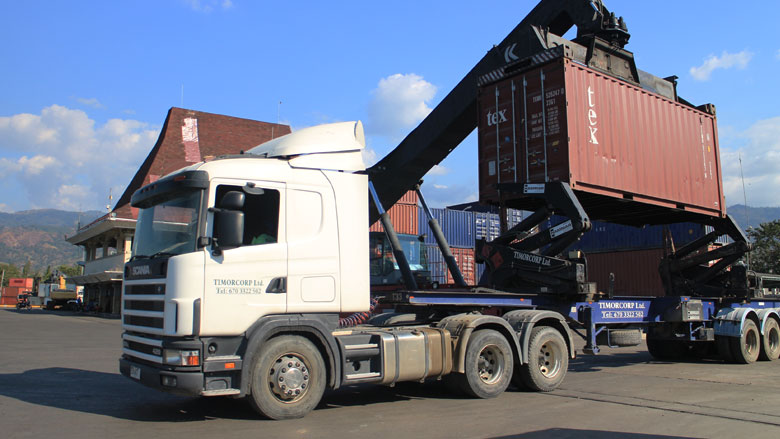December 2021 Timor-Leste Economic Report |
Steadying the ShipReport Page | Press Release | Download report (.pdf) |
Key Findings- After dual COVID-19 and natural disaster shocks, available data points to some signs of economic recovery. Receipts from sales and excise taxes rebounded while household credit expanded as government executed a nominally higher budget in Q2 2021.
- The COVID-19 situation has begun to improve. The pace of vaccine rollout continues to accelerate as nearly 71 percent of the eligible population has received one dose and about 46 percent are fully vaccinated. Nevertheless, there is considerable disparity of vaccine coverage.
- The Government collected 11.3 percent less domestic revenue during the first half 2021 compared to 2020. Public spending grew by 20.3 percent, but capital spending remains relatively low.
- Inflation increased to 3.6 percent in the second quarter of 2021, the highest reading in eight years, driven largely by rising food, beverage, alcohol, and tobacco prices. Private sector credit growth doubled to nearly 20 percent, driven by household credit. Outlook and Risks
- Non-oil GDP contracted by 8.6 percent in 2020 but is projected to recover by 1.6 percent in 2021 on account of base effects and COVID-19 related fiscal expansion.
- Uncertainty surrounding the growth outlook is high, given that COVID-19 is still evolving locally and globally. Rapidly expanding vaccination coverage is key to containing the pandemic and economic recovery.
- Despite a reduced allocation and more coherent budgeting, allotment for recurrent spending in 2022 budget grows by 24 percent than the 2015-2019 average. In contrast, sustainable sources of revenue are set at nearly 40 percent lower than the recurrent spending. Fiscal deficit is projected to narrow in 2022, but still rather elevated at around 40 percent of GDP.
|
May 2021 Timor-Leste Economic Report |
Charting a New Path
Report Page | Press release | Download report (.pdf) |
Key findings: - COVID-19 is spreading quickly throughout the country, despite early successes in containing the virus. Meanwhile, flooding and landslides have caused considerable human loss and economic damage. These compounding health and humanitarian emergencies are undermining the economic recovery in 2021.
- The economy contracted by about 7 percent in 2020, the largest decline since independence. Public health measures and lower consumer confidence weakened private consumption, while political uncertainty in early 2020 undermined public spending – by delaying the approval of the 2020 budget. Moreover, international travel restrictions hampered exports of services.
- Public expenditure declined by 9 percent in 2020. Capital spending nearly halved, but public transfers increased to support households. Domestic revenues suffered from lower economic activity.
- The fiscal deficit eased to 26 percent of GDP – mostly due to lower spending – but remains very large. The deficit was largely financed by withdrawals from the Petroleum Fund.
- Exports nearly halved, owing to limited travel services but also lower coffee earnings.
- GDP is forecast to grow by 1.8 percent in 2021, which is lower than the 3.1 projected in October 2020. The economy is expected to recover in the medium-term, but structural constraints will remain an impediment to faster growth. Reforms to boost productivity and competitiveness are critical.
- COVID-19 remains the key risk to the outlook, as it may require prolonged containment measures to avoid large human losses. A swift vaccination rollout is more critical than ever.
|
October 2020 Timor-Leste Economic Report |
Towards a Sustained Recovery
Report Page | Press release | Download report (.pdf) |
Key findings: - The COVID-19 pandemic and renewed political instability have taken a heavy toll on the economy. The lack of a 2020 budget constrained public spending, while public health measures and voluntary changes in behaviour have weakened private sector activity. However, an
- The economic response package – financed through a special fund – provided some relief to households and businesses.
- Public expenditure declined by 7 percent in the first half of 2020. Spending on capital projects was particularly affected. Domestic revenues suffered from lower economic activity and temporary relief measures (e.g. electricity subsidy).
- Exports declined by 46 percent in the first half of the year, mainly due to lower travel services. Imports decreased by 20 percent, with services declining further than goods.
- Gross domestic product (GDP) is expected to contract by 6.8 percent in 2020 due to the combined impacts of COVID-19 and political uncertainty (earlier in the year).
- A second wave of COVID-19 infections is a key external risk to the outlook, while political instability remains the main internal risk. Strengthening health preparedness and building a durable political consensus are important preconditions for a robust and sustained economic recovery.
|
April 2020 Timor-Leste Economic Report |
A Nation Under Pressure
Report Page | Press release | Download report (.pdf) |
Key findings: - Economic prospects for 2020 have been weighed down by the lack of a state budget for 2020, renewed political uncertainty, and the global COVID-19 outbreak
- GDP is currently forecast to contract by nearly 5 percent in 2020, although this projection remains highly uncertain.
- Public spending is likely to be constrained for most of the year, due to the duodecimal regime in place and execution delays owing to COVID-19.
- A $250 million withdrawal from the Petroleum Fund was approved, 60 percent of which allocated to prepare and respond to the COVID-19 pandemic.
- Timor-Leste has implemented several public health measures to help contain the spread of the virus, including: restrictions on international travel, school closures, rules on access to commercial premises, mandatory confinement of those infected or entering the country, ban on public gatherings, and minimum services for the public administration.
- An effective response to COVID-19 will require measures to contain the virus and strengthen the capacity of the health system, protect vulnerable households, support affected businesses, and ensure the continuity of public services
|
| |
